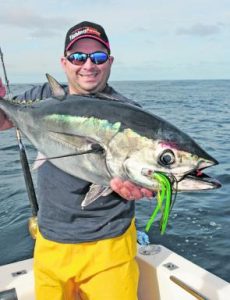How to Catch Tuna Trolling a Guide to Tuna Trolling
Trolling is a method of fishing where one or more fishing lines, baited with lures or bait fish, are drawn through the water behind a moving boat. If you’re a fishing enthusiast, there’s nothing quite like the thrill of hooking a tuna while trolling. Tuna trolling is not just about catching fish….it’s an art, a science, and an adventure all rolled into one. In this guide, we’ll take you through everything you need to know to master the art of tuna trolling and HOPEFULLY have you bringing home a prized catch.
Equipment Needed for Tuna Trolling
Before you set out on your tuna trolling adventure, it’s crucial to make sure you have the right gear. Here’s a rundown of the essential equipment you’ll need.
- Rods and Reels… Opt for heavy-duty trolling rods and reels capable of handling the strength and speed of tuna. Check out our post for the best Rods and Reels
- Lines… Choose high-quality, braided fishing lines with a test strength of at least 50 pounds to withstand the fight with a tuna.
- Lures and Baits… Tuna are attracted to a variety of lures, including diving plugs, feathers, and squid skirts. Experiment with different colors and sizes to find what works best. We think green works best and always start with that.
- Terminal Tackle… Stock up on swivels, leaders, and hooks designed to withstand the force of a tuna strike.
- Check out our post on Spreader Bars
 Super Strong Braided Fishing Line
Super Strong Braided Fishing Line
Where to Find Tuna While Trolling
Searching for tuna can be an exciting adventure. It can also be extremely frustrating unless you know what you are looking for.
Tuna can be found in both offshore and nearshore waters, depending on the species and the time of year. Generally in the summer months you will have an easier time finding schools of tuna. Typically, they will stay near the surface of the water while hunting for schools of bait fish. In the winter months, tuna tend to hunt deeper and rarely venture up to the surface. Additionally, tuna fishing is usually better in low light conditions, such as those in the late afternoon.
To increase your chances of success, research local fishing reports, consult with experienced anglers, and keep an eye on oceanographic conditions. Look for signs of tuna activity, such as diving birds, feeding frenzies, or floating debris, which can indicate the presence of baitfish and attract hungry tuna.
Trolling for Tuna Techniques and Tips
Trolling is a tried and true method for targeting tuna, but it requires finesse and patience. Here are some tips for mastering the art of trolling.
- Speed Matters… Tuna are fast swimmers, so adjust your trolling speed accordingly. Aim for speeds between 5 and 10 knots, depending on the lure and sea conditions.
- Depth Control… Use downriggers, planers, or diving weights to control the depth of your lures and keep them in the strike zone.
- Keep an Eye on the Spread… Spread out your trolling lines at different distances and angles behind the boat to cover a larger area and increase your chances of attracting tuna.
- Stay Alert… Pay close attention to your rod tips for signs of strikes or irregularities in the trolling pattern. When a tuna hits, be prepared for a powerful fight!
Tuna trolling requires patience and perseverance. It’s not uncommon to spend hours on the water without a bite, but don’t lose hope! Stay focused, keep your lines in the water, and be ready to spring into action when the moment comes. Remember, the thrill of hooking a tuna makes the wait well worth it.
How to Land a Tuna
Congratulations, you’ve hooked a tuna! Now comes the fun part, landing your prize catch. Here are some tips for safely and efficiently bringing a tuna on board.
- Keep the Pressure On.. Maintain constant pressure on the fish to tire it out and prevent it from shaking the hook.
- Use a Gaff or Net.. Once the tuna is tired out, use a gaff or a large landing net to hoist it aboard. Be careful not to damage the fish or your equipment in the process.
- Bleed and Chill.. To preserve the quality of your catch, bleed the tuna immediately after landing by cutting its gills and then chill it on ice as soon as possible.
Tuna Fishing Ethics
As responsible anglers, it’s essential to prioritize sustainable fishing practices to ensure the long term health of tuna populations and marine ecosystems. Always adhere to local regulations regarding catch limits, size restrictions, and seasonal closures. Consider practicing catch and release for smaller tuna or species in decline, and minimize your impact on the environment by properly disposing of trash and fishing gear.
Tuna trolling is more than just a hobby; it’s a way of life for many anglers who crave the thrill of the chase and the satisfaction of landing a prized catch. Armed with the right gear, knowledge, and techniques, you’re ready to embark on your own tuna trolling adventure. So cast off, explore new waters, and reel in the big ones. Happy tuna fishing.
 Penn Tuna Spinning Fishing Reel
Penn Tuna Spinning Fishing Reel Okuma Trolling Reel
Okuma Trolling Reel Cedar Plugs Tuna Fishing Lures
Cedar Plugs Tuna Fishing Lures Blue Fly Fish Saltwater Trolling Fishing Lures
Blue Fly Fish Saltwater Trolling Fishing Lures Saltwater Trolling Lure for Tuna
Saltwater Trolling Lure for Tuna Rigged Trolling Flexi Spreader Bar Topwater
Rigged Trolling Flexi Spreader Bar Topwater 36″ Skipjack Hybrid UV 8″ Blue & Pink Mackerel Baits
36″ Skipjack Hybrid UV 8″ Blue & Pink Mackerel Baits Mini Spreader Bar
Mini Spreader Bar